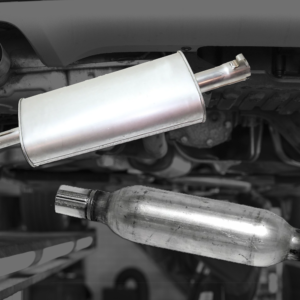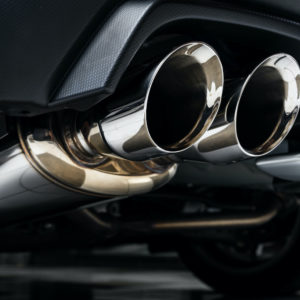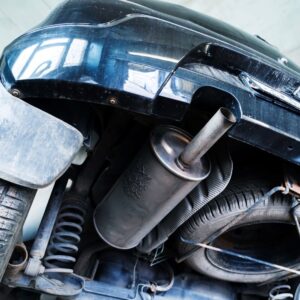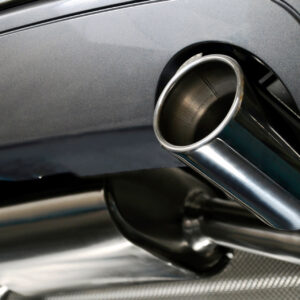Are you thinking of replacing the muffler in your car or truck? There are several types of mufflers to choose from. Each type has advantages and disadvantages, so it’s important to learn about them to make an informed decision on the best car muffler for your needs.
What Are the Common Types of Mufflers?
Let’s check out the most common types of mufflers:
Chambered Mufflers
The chambered muffler is the most prevalent type. It gets its name from the chambers inside the muffler: the central chamber and resonating chamber.
Also called the resonator chamber or simply resonator, the resonating chamber amplifies and tunes the exhaust sounds into something more attractive and pleasant to human ears. The muffler can have multiple resonators and lays them out at specific lengths. Combined with metal plates, the chambers bounce sound waves together, causing collisions that cancel out the opposite waves. This phenomenon is called destructive interference. It lowers the exhaust noise level, making your vehicle quieter.
Chambered mufflers can have multiple resonating chambers. The more resonators are present, the softer the exhaust sounds get. Resonators also eliminate certain sounds while allowing others to pass through, changing how the exhaust system sounds during operation.
The resonator chamber’s size also contributes to the muffler’s exhaust tone and noise reduction. Larger chambers can reduce noise more effectively than their smaller counterparts. However, larger chambers also take up additional space, are heavier, and cost more.
Some chambered muffler products have baffles in their chambers. Baffles are tubes with holes in their walls. They’re inserted into the muffler and let exhaust gas escape through their porous walls, reducing the sound through what’s called pulse reflection.
Depending on their length and the size of their holes, baffles can deliver markedly different performance. If the baffle is short and has small holes, it maintains regular back pressure but doesn’t lower noise levels by a large margin. Conversely, longer lengths and larger holes will significantly muffle the sounds made by the fast-moving exhaust flow. Sound-absorbent packing material can further reduce the noise level.
A chambered muffler can help the engine breathe better. It also provides reduced restrictions on engine performance.

Straight-Through Mufflers
The straight-through muffler gets its name from the perforated central tube that passes through the entire device. Exhaust flow can go through the muffler’s tube with minimal interference. The perforations in the tube’s walls allow some exhaust gases to leave through them, reducing and changing the noise made by the exhaust flow.
Some straight-through mufflers use a chambered canister. Other mufflers have a round chamber surrounded by sound-absorbent packing material.
Straight-through mufflers offer several advantages over other types. First, their simple arrangement minimizes resistance to the exhaust flow. Exhaust gases can pass through the device faster.
The straight-through muffler also improves the engine’s performance. By speeding up the exhaust flow, the muffler enables the engine to generate more horsepower while burning less fuel.
A straight-through muffler also changes the exhaust flow’s volume and sound according to the engine’s output. At the lower RPM of idle and cruising speed, the muffler makes the exhaust sound mellow. But when you throw the throttle wide open for high RPM, the exhaust takes on a deeper and more aggressive tone.
Glasspack Mufflers
A type of straight-through muffler, glasspack mufflers get their name from the fiberglass packing material between the perforated center tube and the larger outer tube. The fiberglass absorbs the sound energy of exhaust gases that exit the center tube’s holes.
Compared to other muffler types, glasspack mufflers provide less sound reduction. They don’t slow exhaust flow, so the gases still make a ruckus as they leave the muffler.
A glasspack muffler occupies less space than other mufflers. It’s a great choice if you have to save space and weight in your car.
Turbo Mufflers
Despite their name, turbo mufflers aren’t related to turbochargers. However, you can install a turbo muffler in a vehicle with a turbocharged engine.
What sets turbo mufflers apart from other muffler types is their pipe arrangement. In turbo mufflers, the perforated tubes form an S-shaped pattern. Exhaust gases must cover a greater distance before they can leave the muffler.
A turbo muffler is very effective at reducing noise levels. Vehicles with a turbo muffler are much quieter on the road.
The downside of a turbo muffler is restricted exhaust flow. The S-shaped piping slows down exhaust gases, affecting back pressure in the exhaust system and potentially reducing engine performance.
What Type of Muffler Is Best For Your Car?
How can you decide what type of muffler meets your requirements? Here are the factors that you might want to consider when choosing a muffler type for your vehicle:
Noise Reduction
If you prioritize muting the exhaust flow over engine performance, a turbo muffler offers the best level of noise reduction. But if you don’t want to hamper your vehicle’s performance, go with a chambered muffler that reduces noise levels without affecting back pressure.
Sound Adjustment
What do you want your vehicle to sound like? Exhaust flow contributes a lot to the sounds your vehicle makes.
A glasspack muffler alters exhaust flow noise the least. If you want everyone to hear your vehicle’s engine, this is the one you want.
If you want your vehicle to change its tone at different speeds, go for a straight-through muffler.
Finally, a chambered muffler can tune the sounds made by exhaust flow. Look for one that can bring out the sounds you want for your car.
Available Space
It doesn’t matter how well the muffler performs if it can’t fit in your vehicle’s exhaust system. Not only does it need compatibility with your car or truck, it must also be the right size.
Glasspack and straight-through mufflers are the most compact types. You can easily fit them in your vehicle’s exhaust system.
Adjust Your Engine Sound With New Mufflers
Mufflers can alter your vehicle’s exhaust note, and most will primarily dampen exhaust notes. They can also make your vehicle sound sportier without disturbing your neighbors. Looking to get a new muffler for your vehicle? CarParts.com has you covered.
CarParts.com is a one-stop shop for high-quality aftermarket components like mufflers. We source our mufflers from leading exhaust component brands like Walker, Ansa, and Magnaflow, to name a few. Enter your ride’s year, make, and model into our vehicle selector to view compatible parts. Get your order in as fast as two business days, thanks to our strategically located warehouses.
Check out our selection of mufflers here at CarParts.com and order one today!
Any information provided on this Website is for informational purposes only and is not intended to replace consultation with a professional mechanic. The accuracy and timeliness of the information may change from the time of publication.























